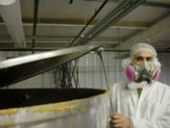FLAVORINGS-RELATED LUNG DISEASE
Exposure Control
NIOSH recommends that employers minimize occupational exposures to flavorings or flavoring ingredients by implementing standard industrial hygiene practices in order as listed below:
- Substituting less hazardous material or materials. This step should be completed after carefully evaluating potential substitutes for toxicity.
- Using engineering controls such as closed systems, isolation, or local exhaust ventilation. A 3-year evaluation of exposure controls implemented at a microwave popcorn production facility, including engineering controls, showed that they markedly reduced air concentrations of flavoring chemicals (Kanwal et al 2011). Additional NIOSH research addresses an especially important potential source of diacetyl exposure, mixing tanks (Hirst et al 2014). The authors note that when working with flavoring ingredients, the use of closed transfer procedures is the preferred control technique. However, when closed transfer is not in place or feasible, simple, relatively low cost exhaust hoods provide a reasonably effective approach to controlling evaporative emissions from mixing tanks used in producing flavorings and flavored foods.
- Instituting administrative controls such as good housekeeping and work practices which minimize exposure.
- Educating employers and employees to raise their awareness of potential hazards and training workers on proper procedures and use of engineering controls.
- Using personal protective equipment where needed in addition to primary engineering or administrative controls.
- Respirators used to minimize exposures to flavoring-related chemicals should protect against both organic vapors and particulate matter. Protection for acid mists may be required, depending on what chemicals are utilized in production.
- Monitoring occupational exposures and the status of workers' health, tracking potential symptoms or cases, and reporting such symptoms or cases to NIOSH and state health departments.
- Workers exposed to flavoring chemicals in flavoring manufacturing plants, and workers exposed to butter flavoring chemicals in the production of different food products, should have their lung function checked with spirometry on a regular basis to detect abnormalities or excessive declines in lung function that may be work-related.
NIOSH has developed guidance in a variety of areas to reduce workers’ exposures to diacetyl through engineering controls, best work practices, and techniques for monitoring airborne diacetyl exposures. Although these guidelines emphasize diacetyl, they can be applied to reduce exposures to diacetyl substitutes such as 2,3-pentanedione and other alpha-diketones. To view the guidelines, visit Best Practices: Engineering Controls, Work Practices, and Exposure Monitoring for Occupational Exposures to Diacetyl and 2,3-Pentanedione.
NIOSH does not have authority under the Occupational Safety and Health Act to issue regulations. For information on OSHA's current policy on regulatory protection for workers exposed to flavorings, see the OSHA flavorings web page .
References
1Hirst DV, Dunn KH, Shulman SA, Hammond DR, Sestito N [2014]. Evaluation of engineering controls for the mixing of flavorings containing diacetyl and other volatile ingredients. J Occup Environ Hyg 11(10):680-687.
2Kanwal R, Kullman G, Fedan KB, Kreiss K [2011]. Occupational lung disease risk and exposure to butter-flavoring chemicals after implementation of controls at a microwave popcorn plant. Public Health Rep. 126(4):480-494.
- Page last reviewed: August 11, 2011
- Page last updated: September 29, 2015
- Content source:
- National Institute for Occupational Safety and Health Respiratory Health Division


 ShareCompartir
ShareCompartir
